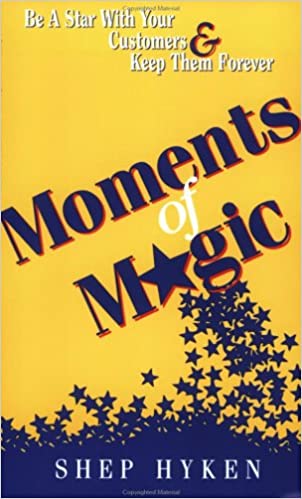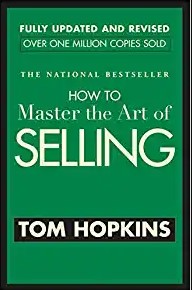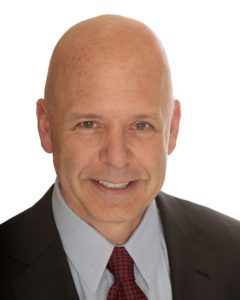Customer service and experience expert Shep Hyken talks about the art of creating exceptional customer experiences and how you can do it easily.
Winning over and retaining customers hinges on whether or not you can provide a great customer experience. If you want loyal customers, you have to build relationships with them and create “magic moments” that keep them coming. This is the central piece of our episode as I sit down for an insightful conversation with Shep Hyken, the leading customer service and experience expert. Shep talks about how he learned to create great customer service experiences and how you can set a gold standard for your company.
As the leading expert in the art of customer service and experience, Shep is an award-winning keynote speaker, a New York Times and Wall Street Journal bestselling business author, and trust me, he’s got incredible wisdom to share with all of us. Our guest is Shep Hyken. As an ‘Amazement Officer’ at Shepard Presentations, he works with companies that want to build loyal relationships with their customers and employees. Tune in and get inspired to start implementing some of Shep’s practical, yet life-changing tips.
Listen to the podcast here:
Download the audio file here.
Creating ‘Moments of Magic’ Within Your Customer Experience
In our interview, we discussed the importance and difference between customer service and experience, how it reflects the leadership of a company and how you have to look at it, not only for the people that pick up the phones and emails, but it’s a company philosophy across the board. We have touched so many important topics, the difference between building loyalty and lifetime value with your clients versus marketing gimmicks in order to get them to come back. I urge you to read and see how important customer service plays a role in your success. Without further ado, here is my interview.—
Shep, thank you so much for joining me on the show.
It is a pleasure to be here. Thanks for having me.
We chatted before we got started. I’m going to tell it now, for the whole world to know that I’ve been following you for years. I’ve been reading what you have put out and the books that you wrote. You have the customer service track on videos, lessons and so on and so forth, including the emails that I get on an ongoing basis. At one point, I said, “I can believe it. It’s years now, this show is out and we didn’t have you as a guest.” I reached out and I’m happy that we’re able to make this work.
Hopefully, this will be the first of many times that we are together.
The first question I will always go, which we like to put things in perspective for our audience. You’re covering a topic about customer service, customer experience and we’ll dive into the difference on those two and everything around it. How did you get to speak on this topic or how do you get the excitement of being the leading expert in this topic versus a bunch of leaders about culture and leadership, all the larger story and they forget about what makes you the money, which is the real customer experience?
There are plenty of great people out there that talk about marketing, leadership and culture. As you mentioned, I ended up in the customer service and experience world because when I was a little kid, that’s what I was taught to do. I worked at my grandpa’s drugstore when I was a real little kid. I worked there in the summer when I was 8 or 9 years old. He let me come in three days a week. I don’t know what I did.
I did an inventory of the greeting cards. I cleaned shelves. I didn’t learn how to run the cash register and be nice to people. That was the start of customer service training. I started my own business when I was twelve. I was a magician. I did birthday party magic shows. I eventually worked in nightclubs and grew into adult programs working at corporate events.
[bctt tweet=”Even if you invent the best lawnmower in the world, unless you have a way of selling it, you’re going to have a warehouse full of lawnmowers.” via=”no”]
When I was doing those magic shows, my mom would say, “Did you write a thank you note?” “No.” “These people paid you a lot of money. How can you not write a thank you? This is a great idea.” My dad said, “Call them up. Make sure they were happy.” That was called getting feedback. I didn’t ask them, “On a scale of 0 to 10, what’s the likelihood you’d recommend me, like the Net Promoter Score?” I asked them, “Were you happy with the show?” My dad said, “Get specific. What did you like about the show? What were your favorite tricks? If you do this a bunch of times, they’ll tell you the tricks they like and then you’ll notice there may be some tricks that nobody ever talks about.”
Get rid of those tricks and put in tricks they will talk about. That’s called process improvement. I’m 12 or 13 years old. I’m learning business lessons, not realizing this is part of customer service and experience. Let’s cut to I eventually started working in nightclubs. I’m in college. I’m doing regular jobs too. I remember when I was in high school, I pumped gas. I’m in the oil business, “What do you do? I pumped gas.” Even then, I knew the right thing to do was to take care of customers. It was a very cold day. We were a self-service gas station, which means that you would come in and pay or you pumped your own gas.
An elderly woman pulled up on one of the coldest days I can remember. I said, “Let me pump the gas for you.” I did it for her and she said, “Thank you so much.” I went in and my manager said to me, “Why did you do that? Now she’s going to expect that.” I go, “I’m glad she would because if I’m here, I’m happy to pump her gas because that means she won’t go across the street to the gas station that’s over there, the one on the opposite corner.” He was irritated with me. I knew that was the right thing to do.
I went to work for that oil business full-time while I was in college. Eventually, out of college, I became a region manager for a very short time. Literally, I graduated at the end of May. In June, I became this region manager. In September, they said, “We’ve sold the company.” I stuck around for a short period of time then, “What am I going to do?”
I saw a couple of motivational speakers. I thought, “I could do that.” It was Zig Ziglar, who you may be familiar with and Tom Hopkins, an amazing sales trainer. I needed to do something with my life because having worked for this company, I thought I’d be there forever. That wasn’t going to happen. When I saw those guys, I said, “I can do a speech. I have an entertainment background. I worked in nightclubs. I did corporate events. I can write a speech instead of a magic show. Now I’ve got to just think about what I want to write about.” I went to the bookstore and there was maybe one shelf of business books.
Now, there are racks of them. I was drawn to In Search of Excellence by Tom Peters, which came out about 1983. I was drawn to books by Ron Zemke and Karl Albrecht. They wrote about customer service. One was called Service America. I bought these books. I devoured them. I wrote my speech. I had bought the Zig Ziglar motivational tapes called See You at The Top. Tom Hopkins had a book called How to Master the Art of Selling. I have both of those still and have no way to listen to the tapes, but I can still read the book.
I digress, but I listened to those. I went to the bookstore or the magazine store and I bought every business magazine, which was five of them. I tore out all the full-page ads. I started calling the companies and asked if they needed a speaker. If they were big enough to have a full-page ad, they probably had a meeting. I’d call the VP of marketing or sales. I’d get through. Back then, for whatever reason, you picked up the phone and called people.
Sometimes you got them. Sometimes you didn’t. I got through. I go, “What are you going to talk about?” “I talk about this concept about an amazing customer experience. I call it Creating A Moment Of Magic.” Hence, the magic background and eventually my first book titled Moments of Magic. That’s my whole life story. Not including the fact that I got married and have kids.

I want to dive into some of the key points that I heard while you were giving me this introduction. There are two things that I want to dig deeper for our readers that we literally could take action on, which is, first, you knew I could do something with my life. The words are similar or something along the lines that you used. Second of all is, you took action even on the sales side. You could have this passion, “I want to be a speaker.”
Sitting behind a computer and trying to say, “I want to be a speaker. I’m waiting for somebody to knock on my door,” or you say, “I’m going to take those magazines, rip out those pages and even if it’s hard, out of comfort, but I got to start somewhere.” How much do those two things, something that really started your career, which means you could have been for years thinking about doing this, but never starting off?
I’ve got a line. It’s a perfect line. It’s paraphrasing a friend of mine, Bud Dietrich, who was a magician. He passed away. He was my mentor. I met him when I was a teenager and I was doing magic shows. He was a great guy. When he did all these corporate events and I told them what I wanted to do. He said, “The only way you’re going to be successful is if you work 40 hours a week. What I mean by work is that you will figure out who you need to call, call these people and tell them, ‘This is what you do.’ You need to spend 40 hours a week getting business. If you want to work on your speech, you can practice that in the evenings, weekends and write it whenever you want to write.”
You can use this in many different types of businesses and I paraphrase it, “The job isn’t doing the speech, it’s getting the speech.” People think I’ve got this great book. In my book, I’ll Be Back: How To Get Customers To Come Back Again and Again, the job isn’t really to write the book. Anybody can write a book. You want to write a good book. That’s a lot of work, but you got to get people to read the book. If you invent the best lawnmower in the world, unless you have a way of selling it, you’re going to have a warehouse full of lawnmowers.
You see it with so many software, technology and even service providers. They weren’t the first in the market, but they would have first gone out there and gotten in front of people.
Maybe I was too young to be afraid of rejection. Tom Hopkins addressed this in his book and so did Zig Ziglar in his talks. It’s a numbers game. Here’s what I came up with this. I don’t know how I came up with this, but I would make this list and I had to go to the library. There was no internet. I would get the magazines, pull out the ads, go to the library and find the ad because sometimes they had phone numbers in the ads, but they were always to someplace other than the headquarters. I’d find the headquarters number. I’d find out who the name of the person was and I created this list.
I created a list of 100 people. I said, “I’m just going to go through these one at a time. I figured I could make 15 or 20 calls a day, I’m going to get there.” Eventually, I became very scientific about it. I said 100 calls a week. Out of 100 calls a week, I’m only going to talk to maybe, if I’m lucky, 15% of the people I call will be available to talk to. Of that 15%, about 12% to 15% of those people showed some interest. Of those people, I may be booked 1 or 2 speeches. When I laid it all out and then I realized the way to get more speeches is not to keep making phone calls. It’s to be so good that they call you back, that they want to refer you and then you can ask them.
My goal was if I did a speech, I want to replace it with another speech. I want to be so good that they bring me back next year, so good that they could use me in a different part of the company, that type of thing. At the crux of it all, the beginning of it all, I had to pick up the phone and call somebody. I recognize it. Tom Hopkins says it’s a numbers game. If you have to call five people to make one sale, four of them are going to say no, but know that you’re closer to getting to a yes. It was a little bit bigger number for getting a booking for a speech, but the same premise.
[bctt tweet=”It’s a numbers game. If you have to call five people to make one sale, four of them are going to say no, but know that you’re closer to getting to a yes.” via=”no”]
I appreciate this for our readers as well because when we started, and obviously we have different services, I remember literally picking a corporate building, a building full of offices, a commercial building, and knocking from door to door. I said, “Regardless of how much I’m going to get, as I’m going to grow my company, I’m going to have the salespeople, I want to be able to relate to them.”
When I send them out knocking on doors, I want them to be able to know that I’ve done it. Let’s have a conversation about how to go about those things. It’s important. I sit with so many business owners and I have this business idea. I always tell them, the first thing I said, “Not every business is an idea. Not every idea is a business. It’s the execution. It’s, ‘Do you have an idea and the plan of execution and you need our help or you just have an idea,’ because so many ideas start and stop and end exactly where it started.”
It’s like somebody says to me, “I want to do a podcast. Will you talk to me?” I go, “I will, but before we talk, I need you to answer some questions.” I send an email, “Number one, what is it you’re going to talk about? Number two, do you know who your audience is? Number three, why are you doing the podcast? Number four, what’s the plan to get this podcast out there? Answer those questions for me and then we’ll talk.” Most people don’t call me back. The reason is because they hadn’t thought about that. By the way, just asking them to do those questions makes them realize, “Either this is for me or it’s not for me.”
I have a great publisher I’m working with for my books. The reason they love working with me is I promise them sales. I tell them exactly what my plan is going to be. The first two books were self-published that I did years ago. I’ve sold probably more of those than any other book too. When I worked with my first publisher, Wiley, they said, “What’s your marketing plan?” Before they would commit to me, they wanted to know what my plan was.
I called it Project 10,000. I’ve used Project 10,000 on a number of books with the idea that I would sell 10,000 books before the book came out, so when the book did come out, we could have a big splash in the marketplace. I remember the publisher at Wiley saying, “If you sell 10,000 books, you can probably quadruple that advance for the second book.”
They gave me a nice advance. I go, “Great.” I remember as we were getting closer to the launch date, I said, “How many books have you printed? I’m committed here.” They said, “We’ve printed 7,000.” I go, “I told you I was going to do 10,000. I already sold 7,000. I got another month to go.” That book hit the Wall Street Journal list. I believe it was number 2 or 3 in USA Today.
I had another book come out right after that. We did the same thing, Project 10,000 and that book hit the New York Times List as well as the Wall Street Journal. Everything’s a plan. Nothing happens by accident. Hence, the job isn’t doing the speech. It’s getting the speech. It’s not just writing the book. It’s selling the book.
Let’s speak about the topic that I want to cover because I think it’s important that so many times we neglect, which is they could plan the marketing. They could plan the strategy. Everything around the business is being planned, cashflow, projections, a lot of fail to plan their customer service experience.

Now we’re talking about what I love to talk. That’s my lane.
I’m going to start a question that I’ve been asked many times, even I speak on the topic of customer experience versus customer service. I want to know it from the expert directly, which is, how do you describe the difference between we have great customer service or we deliver a customer experience?
It is a very popular question, the difference between service and experience. You’ll hear people say, “Customer service is what happens when the experience fails?” No. First of all, I believe both of them, but especially customer service. I said this in the very first book. It’s not a department. It’s a philosophy to be embraced by everyone. Everybody has to have that service mentality, the service mindset.
I learned a long time ago that at Disney, everybody has three jobs. The first is the job they’re hired to do. Take a ticket, sweep the park grounds, help somebody on a ride, sell them a snow cone, but that’s their job. The second part of the job, take care of the guest. Number three is to pick up the trash if you see trash on that ground.
Think about that. Taking care of the guests is paramount to everything because that’s what they’re there for. Every business is the same thing. Everybody has a role to play, then everybody has to play an active role in supporting either a customer or somebody that’s involved in the process of doing so. I mean, if I fly on an airplane, I’ve got gate agents and the ticket counter people and the flight attendants.
They’re very frontline. If I realized that somebody took my bag when I checked my bag at the ticket counter and it shows up at the baggage carousel, there are a dozen people that probably touched that bag to get it to the baggage carousel. None of them ever saw me, but that doesn’t mean they’re not involved in customer service or experience. They are.
Let’s go back to your original question. I believe service is a philosophy, but if you look at it the most practical way of thinking of it in terms of what happens, is service is interactions that you have with people. I believe in internal service and external services. Internal is the people you work with, external are your paying customers. Experience includes customer service. It includes the interactions, but there’s much more to it. Years ago, somebody started referring to customer services and customer experience, but it grew from there. It included any part of the experience that the customer has.
If I am a retailer and I have a store when you pull into the parking lot, what’s that experience like? That’s not customer service. That’s part of the experience. If I’ve got a new iPhone and I’m opening the box, it’s like a whole cool experience. Everything is just a box. Steven Jobs said that it was part of the experience he wanted people to have. In addition to that, we offer the experience of great service on top of it. Does that help differentiate?
[bctt tweet=”Everything’s a plan. Nothing happens by accident.” via=”no”]
People reading this have larger customer service departments. As we mentioned, it’s a philosophy. This goes hand in hand with a lot of stuff that we discussed when we speak about culture and core values in a company. Somebody says, “If you have a software and a software developer sitting behind the screen all day long in writing code, who cares if they’re aligned with a core value of the company as a whole?”
I said, “If they are in charge of getting software uptime up, which means is their customer at the end of the day if you care about small business, and therefore you develop the software. If every moment the software is not reliable, it’s against your mission. They have to be ingrained with that culture. They have to understand what it means.”
It’s not like, “I couldn’t care less about who was using the software. I’m just writing code.” The same way with customer service, the whole customer experience, which is the mentality, which is everybody in the puzzle. The person fueling the plane to be on time is exactly the same person closing the gates or the door on the plane.
You said it so well and that’s a great example of the software coder who doesn’t think he or she has any interaction or any impact on the customer. It’s the person in the warehouse, “All I do is I pull things off and I put them in a box.” If you don’t put it in the box the right way and wrap it the right way when it shows up, it’s going to be broken. It’s going to reflect on the company and it’s your fault that had happened. In finance, if we send an errant invoice, it creates an extra step, 2 or 3, that the customer shouldn’t have to go through to get things taken care of.
To your point and I think you get it, it’s spot on. Something you said from philosophical and it’s in the culture, but you also mentioned, there’s a customer service department handling customer service. Maybe we don’t call them customer service anymore. We call them customer support because that’s what they’re doing. We can use the word service as the philosophy but support is the department or maybe there’s a better term for them because our goal is to retain the customer and keep them happy.
They’re calling us with a question and a problem. We want them to walk away saying, “I love doing business with them because they’re always knowledgeable. They’re friendly, helpful and answer my questions and make it easy.” Maybe they should be called the customer retention department or maybe they should be called the revenue generation department because we all know repeat customers are gold. If they come back, the repeat customer will typically spend more money than a one or every great once in a while type of customer.
You’ve been at this for a long time and you have seen it from all sides of the coin. Why is it that some companies are adamant about that experience while others almost neglect it? Is it a leadership challenge? Is it something that the leadership doesn’t just don’t recognize or is it hard to produce? What is it in if we want to improve on that?
There were a couple of questions there. Where do you want me to go first?

First, what is it? Where does it start?
It starts at the top with the CEO, the leader, the owner, whatever you want to call that person who is at the top deciding, “This is what I want my company to be.” We call it creating this service vision. It doesn’t matter if you’re a solo entrepreneur or you have a company that has 100,000 employees. You can have vision and value statements. That’s great.
When it comes to service, we’re engaged a lot of times. We go into the boardroom and even though we are in the boardroom with executives, we ask other players in a company to join us. Some people on the frontline, some people behind the scenes, we want them to feel that they were part of the process of creating this single vision about taking care of the customer.
My favorite example of this is what The Ritz-Carlton did with nine words were ladies and gentlemen, serving ladies and gentlemen. That’s their internal credo. They don’t put it on their building, but a lot of people know about it because they’re famous for it. It is their service and experience vision statement. Horst Schulze came up with this when he was in high school doing a term paper when he was studying college for Hotel Management or a school for hotel management. He brought it with him. It’s brilliant because it is nine words and everybody can remember it and then you create standards or what I would call non-negotiable standards.
We will always return an email or a phone call, whatever the standard you want to put, 1 hour or 20 minutes. We will never make a customer wait on hold beyond whatever. We will always respond to problems or you can create all kinds of standards. We will always greet people with a smile. If we’re a retailer, no one will ever walk in our door where they do not get greeted by somebody. We use a certain language. There are all different ways to create these standards.
These are practical, measurable metrics that you put into place to see, “How are we doing towards our goal?”
Back to the Ritz-Carlton, they have 24 gold standards. They have their commandments, but they have these gold standards. This is what’s cool about the gold standard. It applies to every single person in the organization. In a hotel, this is easier because it’s all based on shifts. You’re going to work an 8-hour shift in the 24 hours. At the beginning of each shift, whether it be the housekeepers, the front desk shift, maintenance, restaurants, the manager will say, “We’re going to remind ourselves about gold standard number three.” They will talk about it for maybe 3 or 4 minutes.
That’s part of their pre-shift meeting then they go to work. I live in St. Louis, Missouri. You’re up there in New York. If I go to the Ritz-Carlton Abu Dhabi, they’re going to have the same gold standard that day. It’s consistent across the entire organization. That’s what’s cool. Horst said that not everybody works every single day, so they’re going to miss weekends, but they have 24 on the 25th day, they start over with number one. At the end of the year, the average employee of the Ritz has probably heard that gold standard repeated to them at least ten times. That’s how you learn. Training isn’t something you did. It’s something you do. It’s ongoing. Sometimes it only takes 2 or 3 minutes at a time.
[bctt tweet=”Everybody has a role to play. And then everybody has to play an active role in supporting either a customer or somebody that’s involved in the process of doing so.” via=”no”]
A question about the process. Somebody is reading this and thinking that, “I have to be overstaffed in order to be able to deliver that experience.” I’m constantly trying to get out, just answering the phone in the first place. What is it? Is it a chicken or egg? You call companies like you mentioned before Disney or even YouLine.com. You’ll get somebody picking up that phone before it rings every hour of the day. I don’t even know how they do it or if they’re overstaffed.
They are not overstaffed. They’re properly staffed. There is a big difference and it’s not easy to do. You only learn it by watching your numbers and understanding. Your goal might be, “How can I make sure?” Here’s where companies make mistakes where they end up becoming inundated with more calls than they probably should. Number one, they only deal with what the customer asked for. There is plenty of opportunities when you understand who your customer is.
Maybe you can tell by pulling up their record what their buying patterns are. This doesn’t matter if it’s B2B or B2C. It makes no difference. You understand your customers. You understand why they’re asking the question and then you understand that they haven’t asked you other questions that other customers similar to this customer have asked, “Why don’t we deal with it right now, so they don’t have to call back?”
You could eliminate a good percentage of calls that come back from the same customers if you took care of business proactively. I have a couple of clients that I’ve worked with that are trying to create a lean situation. I will ask them. We just want to answer the question and move on to the next call. We’re trying to take care of it and stay lean.
I go, “That’s fine. If you know that these people are going to have to call back in three weeks or you should have recommended something to them, but it wasn’t exactly what they asked for, you’re doing a great disservice to both, the customer and to you. When the customer comes back, now you have to reauthenticate them to know who they are. Look them up in the system.”
You already did that. Why are you having to do it again? You wasted not just the customer’s time and money, your time and money by having to go through that process when you could have known now. Nowadays, certain companies have great sophistication in the form of artificial intelligence. We talk about how AI can support the customer support person, even better sometimes than the actual customer.
You call me, I’m an agent and I’m talking to you. The computer is listening to our conversation. It hears what you’re asking about. It’s putting things on the screen to give me answers before I ever even have to type them in or maybe I do have to type them in, but I know exactly what to type in to get the right answer to.
Here’s what else the computer is doing. It’s saying, “Mr. Hoffman is a customer that’s been with us for three years. He’s bought X, Y, and Z. He calls us every 2.3 months with a question. He is just like 1,000 other customers that we have exactly. Here’s the next question he’s going to call about 3 weeks or 2 months from now. Why don’t you deal with it now? Here’s the next product he is most likely to buy. Why don’t you suggest that now? You’re now being proactive.”

Some people call that the upsell and the cross-sell. If you don’t do it and it’s the right thing to do, that’s bad customer service. The is why the sophistication nowadays in certain companies is amazing but go old school. I know clients of mine that are so old school that their salespeople have an index card file that has all their customer information on it with notes. That’s what they’re using to build their relationships with their customers. There’s nothing wrong with that.
You’re going back. It’s a mentality. How you arrive at that destination is up to your infrastructure. Sometimes it’s money involved if it’s technology but the mindset needs to be there regardless. It reminded me story when we spoke about Disney. I remember speaking about Disney and about sharing one of those great stories that are out there about Disney. Somebody says, “There’s a reason why they could do it. They’re Disney. They have a lot of money. They could put extra people on the.”
I remember I was once with Disney behind the scene for the marketing tour. They were showing me. We spoke about this concept. They shared with me, “Look at the park.” There were thousands of people. I can’t remember the exact metrics that they shared, but I think it was like, “60% of the people in the park are there for the 2nd or 3rd time.” That’s based on the metrics. “The reason why they’re coming back is because of the great customer experience. Could we afford not to do it?”
You can’t afford a bad experience. If you want to have repeat business, you have to deliver an experience that gets people to come back again. Hence, the new book. Every book that I’ve written is about how do we get customers to come back? I finally say, “This is what we want our customers to say, ‘I’ll be back,’ and then they do.”
I want to speak about a couple of very specific questions that I’ve prepared because I think these are questions that blur the line on giving great experience or not, where I know a lot of our readers will deal with on a daily basis. All of the questions you probably answered a gazillion times, but we’ll ask it again and we’ll see what you’re going to answer now. There’s always the concept or the line that we use, “The customer is always right.”
Companies have policies and procedures. It needs to make sense. You always have those people that come in with these crazy demands. Where do you draw the line to say, “We’re not diminishing our customer experience, even we have to sell the client. We can do this. It’s two years after the warranty expired. How do you expect us to give you this warranty?” Give us some practical guidelines when those things come. Even if when it arrives, how do we say it not to ruin the long-term relationship?
First of all, I do not believe the customer is always right. I believe the customer is not always right, which is a relief for a lot of people, but the customer is the customer. If they’re wrong, let’s figure out a way to do it with dignity and respect to make them feel comfortable. If they’re calling you for something that’s completely outrageous and unreasonable, you may not have to say no.
You can find alternatives. When we’re finished, I’ll be happy to share with you a Christine Trippi, who has this Pineapple philosophy. One is you never say no. That’s impossible I would say no if it’s illegal and immoral. We have guidelines. We don’t want to lose money as a result of doing something special outside.
[bctt tweet=”There is plenty of opportunity when you understand who your customer is.” via=”no”]
There are all kinds of reasons that you can say yes to other things by offering alternatives. She used the example, “We don’t have a hotel shuttle, but somebody says, ‘Do you have a hotel shuttle?’ You don’t say no and forget about it. You say, ‘We don’t have a hotel shuttle. The best way to get here is,’ and you give them 2 or 3 options. They go, ‘Okay.’”
Some people might be upset, “You don’t have a hotel shuttle. That’s bad.” You can ask, “Is that going to be the difference between you staying here and not staying here?” “Yes, it is.” “Can I recommend a hotel that does have a hotel shuttle?” Do you see where I’m going with this? That way, you don’t have to say no. You recommend alternatives.
The customer is not always right, but they’re always the customer. I’ll tell you a story. I stayed at a hotel in Austin, Texas. I checked out of the hotel early in the morning and then after I was finished with my meeting, I came back and said, “I understand you have the hotel shuttle. I’d like to sign up for the one that leave an hour from now.” The person said, “I’m sorry, you checked out. This is only for hotel guests.” I went, “I know.” I can’t make this up. They don’t know what I do. You know I’m going to write about it in a book or something because I can’t believe this.
I said, “How long have you been here?” “I’m fairly new.” “What did they tell you?” “They told us that occasionally people come in and they’re not guests of the hotel. They cannot use the shuttle.” The rule is made. I’m going to use the word rule. I hate the word rule. It’s a guideline, not a rule. The rule that they imposed was, “If you’re not staying at the hotel, you can’t use the hotel shuttle to get to the airport and park your car on their lot.” That’s what they were trying to avoid. This person said, if you’re not a guest and currently I officially was not a guest, I could not be a part of the hotel shuttle. Is that the most ridiculous thing you’ve ever heard? It’s a function of training.
Another thought on this is there’s an old expression that says, “You don’t want to win a fight. You want to win the customer.” What can you do to win that customer over? Figure out ways. Be flexible. There are people that say, “We try never to say no to a customer.” How do they do it? “Because we teach your people to learn flexibility.”
There’s a concept I wrote about in one of my books, Amaze Every Customer Every Time. I wrote about 1 to say yes, 2 to say no. Hire good people, train them the right way, then let them go out there and take care of the customer and teach them to say yes or find ways to say yes and give them what they want without having to sometimes give them what they want to ask for because you’re not capable and not reasonable.
If somebody comes to me and wants to buy a shirt, I don’t sell shirts. Those stories at Nordstrom, “We don’t sell that shirt, but if you’ll hold on, go shop. I’ll be back in twenty minutes.” They went to another store. They bought the shirt and they brought it back. They would rather take care of that customer, not make any money on that shirt and give the customer what they wanted just because they were out of the shirt or didn’t sell that brand.
It didn’t mean they couldn’t take care of the customer. That’s extreme, but there are many ways. One is to say yes, two to say no means, “I’ll figure out a way to say yes. I’ve got to go to my manager or my boss and ask them to help me because I don’t know how to solve this customer situation,” then the employee learns and never has to ask again.

I will add a great practical tip for business owners reading to this is when the last time you called your own company was.
Mystery shop.
It’s important because sometimes you have to experience it. You’ve put in people and maybe you train them to the extent at that point. You go to do so many other things and you never come back to see how are they doing? You could send out surveys, Net Promoter Scores but real-life experience, sending somebody into your store and go through the experience? How long does it take and what offers are you given and so on and so forth? That’s just the practical point.
In 1988, I started writing my first book, Moments of Magic. I used the Anheuser-Busch as an example that the senior executives had to get into a beer truck and travel around with a route salesman or go on sales call with a salesperson to see what was happening on the frontline, go visit the stores, restaurants and hotels where we sell our product. They had to do that once a quarter.
In the most recent book, I come back to that exact same topic when I talk about how one day somebody called Microsoft for technical support and Bill Gates himself said, “I want to see what’s going on down there. I want to take some of these calls.” He answered the phone, “Microsoft support, this is Bill, may I help you?” He helped this person and a little later on, this person called back and wanted to compliment this young man. He was the CEO of Microsoft. It’s important to know what’s going on with your customers.
This is an actionable step because it should be done on an ongoing basis, “Have your checkpoints. You need to inspect what you expect.” That’s the line you use a lot. In customer service and customer experience, it’s for sure something very important. I want to speak a little bit about the book and we’ll go into a little bit of details on that. Hopefully, we’re at the end of the COVID era. Companies went from offline to online and there are a lot of shifts in the market. What have you seen in the effect of customer experience? Is it harder to deliver? Is it more companies that are going that route? Is there anything that you would share with our audience?
At the beginning of the pandemic, there was a lot of emotion, companies had never experienced what was going on and there were long wait times. There were lots of problems, also customers, we started to see stats and surveys come out. I look at all kinds of reports that are coming out that were saying customers want to talk to somebody more than they’ve ever wanted to before they might go with the self-service route.
There was a 33% increase in customers simply saying, “I just want to talk to somebody,” before they might go online and figure it out themselves. Recognizing all these changes, what did happen if you look back on many changes that did take place. There was an acceleration of adopted ideas, strategies and technologies that would have eventually happened in our world not so quickly.
[bctt tweet=”If you want to have repeat business, you have to deliver an experience that gets people to come back again and again.” via=”no”]
I wrote a book titled The Convenience Revolution. It’s all about convenience. Who would have thought that delivery would become the ultimate convenience, not having to go get my groceries? People are willing to pay for it where years ago, I called the restaurant, “Can I get it delivered?” “Sure.” They deliver it at no charge. Nowadays, you’re going to pay for delivery and you’re going to be happy about it too. There was an acceleration use of technology and principles that we’re using nowadays that we would be using years from now had the pandemic stopped or never happened, but that’s a big change. Customers are starting to learn how to go digital and that’s okay.
Self-service options are great if you do it the right way. You can’t automate the relationship, but you can take part in it and make it easier for a customer. When they learn how easy it is, think about people who fly on an airplane. I can’t remember when it was exactly or how many years ago when Delta Air Lines first came up with the idea that I could go online and book my ticket without having to talk to a reservationist. They gave me an incentive. They said, “Do that. We’ll give you an extra 500 miles on your points and miles.” I said, “I’ll try it.” They all adopted it quickly because the customers loved it. It was easy.
They knew there was a backstop. If there is a problem, they can call the reservationist. Then they started the online check-in. Back then, you had to print your boarding pass out and bring it to the airport. Nowadays, it’s on your mobile phone or your watch. Doing it yourself isn’t a bad thing if it’s making it great for the customer.
Also, I remember a gentleman who, when this was all happening, said to me, “I’ve had the greatest experience on Delta Air Lines.” “What happened?” “I got all the way to the gate and I didn’t have to talk to any of the employees.” I said, “Are the employees that bad?” He goes, “No. They’re great. What was cool is that they’ve created this system where I can do everything online and unless I have a problem, I go to the gate.” He was so excited about it. You see how that works.
I always say that, “Use systems and technology to enhance the experience,” but you still need to support that relationship. That person is doing that online, but if there is a fallback, they need to be able to speak to someone. Great companies will be there to support it. Zappos is a phenomenal website, but if you need to speak to someone, they’ll pick up a phone.
That’s an important part. Some companies will focus so much on technology and so much money on technology, but they’re then hiding the rest of it behind the walls where you can reach them. I want to get a question about the book. I want to tease it because I feel that we’re going to have you back. There’s so much more we want to speak about before the launch, but let’s speak a little bit about the eighth book. All of them about obviously within the realm of customer service, customer experience and everything around it. What’s different about this book?
The book is coming out in September 2021, but if you buy the book, if you go to IllBeBackBook.com, you’ll immediately get the eBook. The eBook is ready to go. We’ll still send you the hardbound book when it comes out. It’ll probably come from Amazon or Barnes and Noble, but you’ll get the eBook immediately. What is different about this book? First of all, every book I write has some similar content. It’s my foundational concepts that have to be set up. I talk about moments of magic, misery, mediocrity and being amazing. That’s one chapter. There are maybe 1 or 2 other chapters that cover some other topics.
I do bring back self-service, eliminating friction and creating convenience. I started looking at a lot of content that I’ve been writing about in the last couple of years. There’s a lot that people need to know about now, especially as we come out of the pandemic. What a perfect title, I’ll Be Back. We’re back from the pandemic. It also ties into getting your customers to come back. I started thinking there’s a lot more content. My editor called me and said, “Have you been working on Convenience Revolution 2.0?” I go, “I played around with it.” They wanted me to do more. I don’t know how much more is it. Just give me time, I’ll come up with it.

There’s a great concept in understanding the difference between satisfied customers and loyal customers or repeat business and loyal business. The measurements that you look at nowadays, people are using customer satisfaction, CSAT, Net Promoter Score, the likelihood you’d recommend somebody. Lifetime Value is a great measurement. The only way to have Lifetime Value is to create a lifetime for your customer. That means getting the customer to come back and understanding why they come back is important because if they come back because you’re a great marketer at you’re a restaurant that you give them a punch card at the end of the five meals, you get the sixth one free, I might be coming back because I want a free lunch.
If you took that away, will you still come back? That’s the question. By the way, there is nothing wrong with creating repeat business. That’s a brilliant strategy. Do not give it up but the goal is to be so good that if that disappeared, you would still go on it. All the airlines, frequent fire miles, if all of those went away, if the free upgrades went away, what would be your favorite airline to fly? Forget about the miles on the perks. Do you have a favorite one? I’m not asking you to answer this. You can answer it if you want if you have an answer, but that’s a great example because, “I fly on them because my frequent flyer programs on them.”
“That’s usually because I’m stuck with them because I have my miles there.”
They’ve created a sticky situation. It’s a marketing program, not a loyalty program and there is nothing wrong with it but when you understand that, then you can say, “What can I add to this to create some emotional connection to make people love us?” Southwest Airlines is known as a very friendly airline. They don’t have first-class upgrades because there’s no first-class. They don’t give you any food. Most airlines don’t do that for COVID reasons.
Prior to that, they give you peanuts and a soda, a drink, a beer or whatever, but they’re not going to give you a meal. If you want a first-class seat and a meal, you’re not going to fly on Southwest, but somehow or another, most people don’t fly first class and Southwest is year over year, quarter over quarter, for the most part, have an unbeatable record of profit every quarter. Forget about 2020, but maybe one quarter they may have missed. That’s unbelievable for a company like that. It’s because their customers will love them.
Let’s close with the four Rapid-fire questions. Are you ready?
I’m ready.
Number one, a book that changed your life.

The Experience Economy by Joe Pine and Jim Gilmore.
Number two, a piece of advice you got that you’ll never forget.
“The job isn’t doing the speech. It’s getting the speech.”
This is a piece of advice I got as well.
“How many is remembered long after price is forgotten?” Aldo Gucci said that. The idea behind it is, “If you pay good money for something really good, it’s worth it.”
Number three, anything you wish you could go back and do differently?
I don’t have any regrets. I don’t even have a bucket list.
I love it because the next question is the bucket list. What is still on your bucket list to achieve?

I do not have a bucket list except for one thing, more time with my wife, children and my family. That’s the only thing that matters. I will do incredible journeys and adventures in the future, but if they don’t ever happen, I have a great life.
Thank you so much for joining us. I know your time is valuable. That is why in the name of our readers, we’ll forever be grateful for sharing some of your time with us.
Thanks for having me. I can’t wait to come back. I’ll be back.
This is an invitation.
Important Links:
- Shepard Presentations
- In Search of Excellence
- Service America
- How to Master the Art of Selling
- Moments of Magic
- I’ll Be Back: How To Get Customers To Come Back Again and Again
- Amaze Every Customer Every Time
- The Convenience Revolution
- The Experience Economy
- https://www.Facebook.com/ShepHykenSpeaker/
- https://www.LinkedIn.com/in/shephyken/
- https://www.Instagram.com/shephyken/
About Shep Hyken
 Shep Hyken is a customer service and experience expert and a New York Times and Wall Street Journal bestselling author. Shep works with companies and organizations that want to build loyal relationships with their customers and employees. His articles have been read in hundreds of publications, and he’s the author of 7 books, his newest book I’ll Be Back: How to Get Customers to Come Back Again and Again will be released September 21, 2021. He is also the creator of The Customer Focus™, a customer service training program that helps clients develop a customer service culture and loyalty mindset.
Shep Hyken is a customer service and experience expert and a New York Times and Wall Street Journal bestselling author. Shep works with companies and organizations that want to build loyal relationships with their customers and employees. His articles have been read in hundreds of publications, and he’s the author of 7 books, his newest book I’ll Be Back: How to Get Customers to Come Back Again and Again will be released September 21, 2021. He is also the creator of The Customer Focus™, a customer service training program that helps clients develop a customer service culture and loyalty mindset.








